Page last updated: December 16, 2020
All pages copyright © 2020 by Pinyon Publishing

SEEING TREES
A POETIC ARBORETUM
Poems & Art by John C. Ryan and Glen Phillips
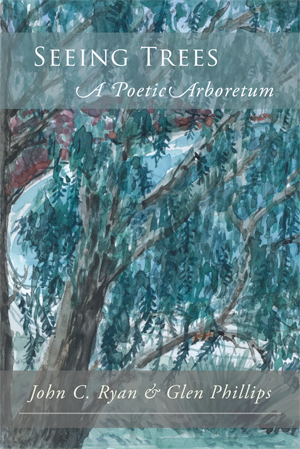
“… I walk inwardly / A while towards eternity. … / The seen was not a scene / But a sensation. The trees’ old way of seeing / Bore winged seeds within my being.”
(“I Turned the Corner and Entered the Mind of the Forest” JCR)
A collaborative current of respect for the earth, steeped in the forests of Australia—poetry and art rich in science, humanity, philosophy, and memory. Like the Lorax, Ryan and Phillips speak for the trees. What does it mean to be a tree? Perhaps it is time. To look and to listen:
“Maybe strange passions moved in us, prompted / by these groves to kneel, loving moonlit land?” (“Coastal Peppermints” GP)
The reader, like the currawong:
“darts among upper / branches, taking chances / with sudden lances / of its beak and / tongue.” (“Figworts” JCR)
We explore the soul of the forest with feathered guides that instill courage:
“This morning, a kookaburra surfed the fence post / outside my kitchen window, headstrong on the squall, / unfussed in the gale, a stubborn figure in a snow globe. / … I remember the sensation of noonlight / sharpening to summer’s taper on my neck near the river / of the black swan, as Sulphur-crested cockatoos wheeled / daredevilishly in a mob on the horizon. … / I think hope is a touch as feathers—a seed scatters, a bird shudders / on spectral wings, sings of things we must have faith in to imagine.”
(“To Spring Hope, Here and There” JCR)
 Born in the United States, JOHN C. RYAN is a poet, critic, ethnographer, and naturalist who lived in Australia for more than a decade. His poetry focuses on the plant life of Australia, North America, and Southeast Asia. His published poetry books include Two With Nature, New Perspectives on Tablelands Flora, Primavariants (with Glen Phillips), The Earth Decides, and Seaweed: A Book of Algae. He edited an issue of Plumwood Mountain on the theme “plant poetics” and co-edited the scholarly books The Language of Plants and Australian Wetland Cultures.
Born in the United States, JOHN C. RYAN is a poet, critic, ethnographer, and naturalist who lived in Australia for more than a decade. His poetry focuses on the plant life of Australia, North America, and Southeast Asia. His published poetry books include Two With Nature, New Perspectives on Tablelands Flora, Primavariants (with Glen Phillips), The Earth Decides, and Seaweed: A Book of Algae. He edited an issue of Plumwood Mountain on the theme “plant poetics” and co-edited the scholarly books The Language of Plants and Australian Wetland Cultures. Born in Southern Cross, Australia, GLEN PHILLIPS was educated in country schools and in Perth, WA. He graduated from the University of WA with First Class Honours in 1957 and MEd (1967). He gained his PhD in Writing from Edith Cowan University (2007). Glen has taught English Literature for nearly 60 years, locally and overseas, especially in China. He is Director of the ECU International Centre for Landscape and Language. More than 60 of his books (50 being his poetry) have been published. Poems also appear in some 40 world anthologies and many national and international journals. Recent books include The Moon Belongs to No One, Singing Granites, Gold in Granite, and In the Hollow of the Land.
Born in Southern Cross, Australia, GLEN PHILLIPS was educated in country schools and in Perth, WA. He graduated from the University of WA with First Class Honours in 1957 and MEd (1967). He gained his PhD in Writing from Edith Cowan University (2007). Glen has taught English Literature for nearly 60 years, locally and overseas, especially in China. He is Director of the ECU International Centre for Landscape and Language. More than 60 of his books (50 being his poetry) have been published. Poems also appear in some 40 world anthologies and many national and international journals. Recent books include The Moon Belongs to No One, Singing Granites, Gold in Granite, and In the Hollow of the Land.Taken into a temperament of ancient humanity, peopled with Noongar, Wadjuk, Jdewat—sensing deep time and our part in the vast history:
“This tree remembers the births you / never saw, including your own—” (“Sanguis Ortus Nativitas” JCR)
With the trees, we claw “skyward towards a portal of light” (“Inside a Jarrah Tree, A Black Tunnel Reaching Skyward” JCR)
“Brick after brick, row after row, our deft / sweeping thrusts bestow a tabula rasa / to this stairway to my stars.” (“Back to Sweeping the Paths” GP)
Tension fueled through the human propensity for destruction, unleashed as through raging bushfires. Power dare we tangle with?
“And then the startled crack / of the still-burning heart / of a once-living casuarina./ … We shutter behind eyelids / each lingering backward glance / to the fire we let consume us.” (“Charred Ground” GP)
“remnant of great tuart forests—once from here / to the Swan River and beyond.” (“In Defence of Tuarts” GP)
“Aeons before the Dutch nosed around Noongar / lands, the Christmas tree was known as ghost tree. / Final refuge before departing souls moved on / to Kurannup away over restless western seas. / Moodjar was therefore name for this hemi- / parasite that clamps a white claw round each / host it finds under the earth.” (“The Friendly Fires of Kambarang” GP)
Daring explorations of form and sound, poems assume shapes of mighty sheoaks and charismatic balgas, orchestrated with primal percussion and intricately layered language. The reader explores the literal limbs of poems as their forms reach out like branches and leaves. Masters of sculpting the intangible onto the page, Ryan and Phillips help us explore new ways of seeing and listening:
“You tease out the oakum of these momentary images / on the workhouse yellowed pine table until fingers ache. / You spread the pale paperbark pages and dip a nib in ink.” (“Unidentified Flying Image of a Poem” GP)
An invitation, youthful traveler—rise out of the sea, inhale eucalypts, taste dust and sun, glimpse a leaf:
“After our dunking all day in clear seas / of Wadjemup’s rock-bound bays, we glimpse / sun is setting behind these paperbarks.” (“Rottnest Tea Tree” GP)
“And yet the path curves on in shadow or sun. // Stroll on, youthful traveler, taste dust and sun, / breathe in scent of eucalypts as you walk, / … Here’s where you’ve come from / … Yet through window light you still glimpse a leaf. // And from the book of youth you take that leaf, / print with your feet the way of the brain’s span / immense; then with the setting of the sun / unleash your fresh young mind and let it run / its imaginings as your footsteps trace from / your place of birth as far as you can walk. // You should cherish walking out, every leaf / at your feet fallen from heat of the sun, / unheeding such spans of time left to run.”
(“Footsteps Among Trees” GP)
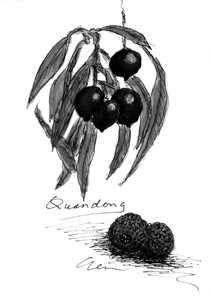
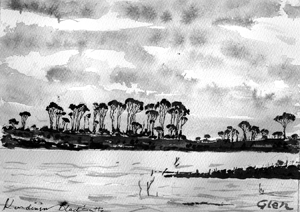
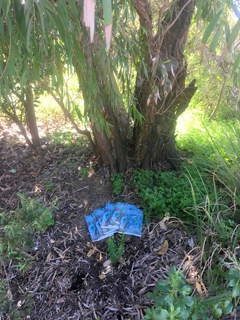
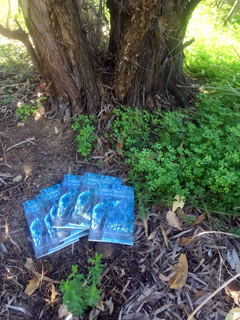
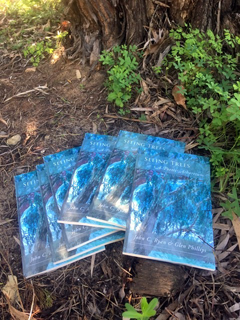
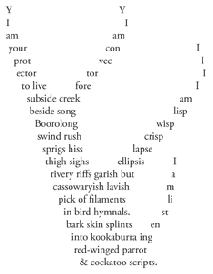
December 4, 2020: Review in The West Australian
“… A rich collection of poems and illustrations which sing of the beauty, the power, and the tragedy of trees … ‘Have you ever breathed inside a tree’ …Glen answers with inky emanations of a tree’s inscape.”
Book Launch in Western Australia: October 31, 2020, 2-3 pm, Moon Café & Zoom (U.S. Mountain Time: October 30, 9 pm). Glen Phillips and John C Ryan welcome your attendance (actual or via Zoom https://us02web.zoom.us/j/942971412) on Saturday afternoon, October 31st, 2-3 pm (Friday evening in Colorado) at the Moon Café, 323 William St, Northbridge to celebrate the world release of Seeing Trees: A Poetic Arboretum, Pinyon Publishing, USA. Co-author Dr John Ryan will appear via Zoom.
Dr Vivienne Glance, performer, dramatist, poet, and writer has kindly agreed to launch Seeing Trees. Local poets will read poems selected from the book and copies may be purchased at the event for $20 (Also from New Editions Bookshop)
